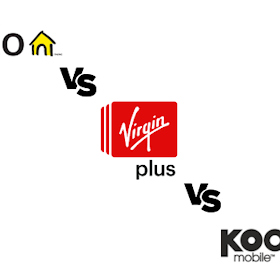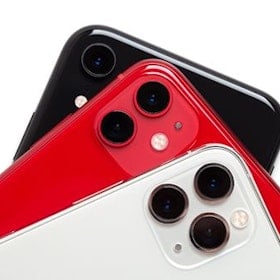One of the trickiest parts of finding a reliable cell phone plan is balancing cost versus data. You don’t want to overpay for data you’ll never use (especially on an unlimited plan), but you also don’t want to risk fees or slowed speeds for exceeding a monthly limit. The only way to avoid wasting money is learning how to monitor your data usage.
While you can track your data in your phone’s settings, it won’t provide much insight into staying within your monthly limit. We went out in search of apps for iPhone and Android that can do that and more. As experts in tech since 2008, we know what’s useful and what’s simply taking up space: we’re sure these apps will provide value, especially if you use them to lower your monthly bill.
Read on to see our list of the three best apps for monitoring mobile data usage.
How we rated the best apps for monitoring data usage
WhistleOut searches for Android and iPhone apps that are easy to use and affordable. We evaluate apps through hands-on testing and rate them on a five-star scale based on the following criteria:
- User experience: We search for apps that enhance the user experience, improving the power of your phone and making your life less complicated. The apps we recommend are intuitive, allowing users to put them to use as soon as they open them.
- Price and value: We select apps that charge minimal download fees and tend to favor apps that don't charge anything. We do include some apps that charge fees, though we guarantee that they're worth the price tag.
- Efficacy: App developers like to talk a big game; we test their products to see if they deliver on their promises.
- Practicality: Your phone has a limited amount of storage, so you don't want to clog it with single-use apps that don't improve your day-to-day life. We reward apps that are worth their weight in data.
- Privacy & security: We evaluate the permissions an app requests, sussing out the legitimate from the suspect. We also scour user reviews on relevant app stores to see if customers are reporting security concerns and investigate the veracity of those complaints.
3 best apps for
monitoring data

My Data Manager VPN
Track your data without sacrificing your privacy
There are several data monitoring apps on the market, but this one offers the most complete package. You can track your data use by the hour, keep your eyes on a family plan, and set alarms for when you’re in danger of racking up overage fees.

Importantly, this is all prevented in illustrative charts and tables, like a personal assistant has prepared a report on your habits. While your iPhone or Android might provide the hard numbers for tracking your data habits, My Data Manager VPN provides the tools for you to actually change them.

Above all, though, what we like most about the app is its commitment to privacy and security. In addition to its data monitoring, My Data Manager VPN uses VPN technology to protect your mobile data when you’re on public Wi-Fi. The app also abstains from collecting your location data. While it does ask you to allow it to collect demographic data for marketing purposes, you can opt out of that request and still use the app.

GlassWire
The sleekest interface for Androids
Free from Google
If you’re looking for the best user experience on a data monitoring app, you won’t do better than GlassWire. The app allows you to easily navigate through the other apps downloaded to your phone and view their daily data use. If you’re suspecting Spotify and YouTube are draining your monthly data bucket, GlassWire will give you the evidence to back it up.

Like My Data Manager VPN, you can also track how much data remains on your monthly plan and set alerts for when you’re approaching an overage. Unlike that app, though, GlassWire is only available for Android, a limitation that we think is unfortunate for the many iPhone owners hoping to use its helpful tools.
GlassWire is now available for free, and includes features like unlimited network history and bandwidth monitoring that were previously only available if you paid a monthly subscription. Now, though, everyone can make use of their tools without paying a dime.

Traffic Monitor with Widget
Detailed data about your data
This one’s for the nerdiest among us. Traffic Monitor provides more detailed breakdowns of your data usage than My Data Manager VPN or GlassWire, allowing you to track your downloaded and upload data by the minute. It’s more in-depth than the casual user needs, but for those users looking for more precise reports it’s a nifty little tool, especially considering it’s free.

The app also includes a handy speed test, which tracks download, upload, ping, and website speed. While testing the speed of your Wi-Fi won’t do much for managing your monthly data allotment, it will let you know if the internet you’re using is fast enough for whatever tasks you’re completing on your phone.
Monitor your data with your carrier's app
Most wireless carriers have their own apps, offering another convenient way to monitor your data usage right from your phone. MyBell, MyRogers, My TELUS, Freedom Mobile My Account and more allow you to pay your bill, talk with customer service, and, yes, track your usage habits. Their breakdowns aren’t as detailed as any of the apps above, but they are free and, importantly, using them means there’s one less app you’ll need to download.
How to monitor data use on an iPhone
Your iPhone allows you to monitor your data usage, though it won’t provide the intricate details that the above apps offer. It also requires a bit of planning.
Before anything else, you’ll need to set a period for your phone to track. If you want to track the amount of data you’re using in a billing cycle, you should do this on the first day of your billing period. Here’s how to set it:
- Open Settings.
- Tap Cellular.
- Scroll all the way down to the bottom of the page until you get to Cellular Usage Statistics. Below that, you’ll see a date next to Last Reset. This is the beginning of the period your phone is currently tracking. If you’ve never reset this before, it will probably be the day you activated the phone.
- Tap Reset Statistics.

Now, your phone is ready to track your data for a set period. You can check back whenever you want by following these basic steps:
- Open Settings.
- Tap Cellular.
- Your data used for the current billing period will be listed under Cellular Data, to the left of Current Period.
If you want to track your data month-by-month, just be sure to hit Reset Statistics every time you reach the first day of your billing period.
How to monitor data use on an Android
Android phones also allow you to monitor your data usage and make the process a little easier than doing the same on an iPhone:
- Open Settings.
- Tap Connections. On some phones, the title might be different, so tap a similar option if Connections is not listed.
- Tap Mobile Data Usage or a similar option if Data Usage is not listed. You’ll see a dropdown menu that allows you to see the usage for a given period of time.

How WhistleOut reviews apps
Our mobile experts scour the app stores every month, looking for the best new apps for Android and iPhone. Before recommending an app, we use the app for at least one full workday, testing its basic functionality and evaluating whether or not it delivers on its promises. From there, we weigh the app's pros and cons, and then determine whether or not it's a worthwhile download for basic cell phone users.
-
Easy to use
Great apps simplify your phone. We selected the tools that don't require a complicated instructional manual. -
Affordability
The internet is filled with expensive price tags, but we're not buying what they're selling. We leaned into inexpensive, quality apps. Extra points if they're free! -
Hands-on testing
We played around with these before recommending them, ensuring they're worth your download.
From there, we weigh the app's pros and cons and then determine whether or not it's a worthwhile download for the wider population of cell phone users.
Related Articles
Find Better Phones and Plans
Hundreds of cell phone plans unpacked. All the facts. No surprises.



































